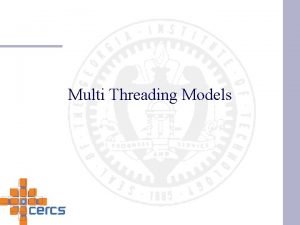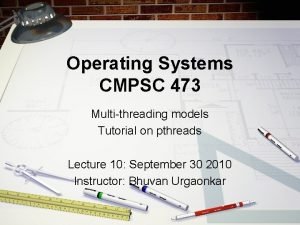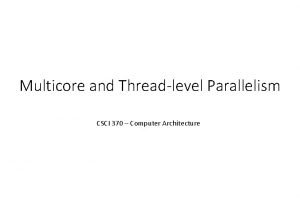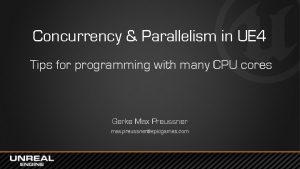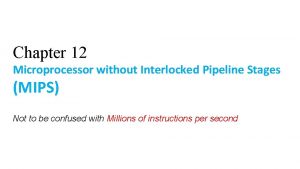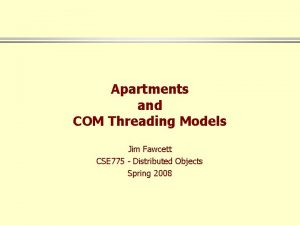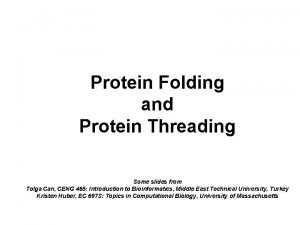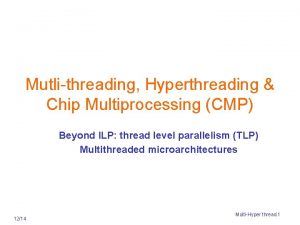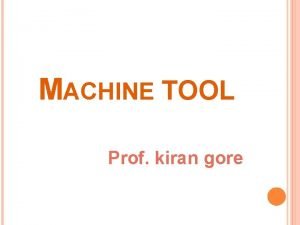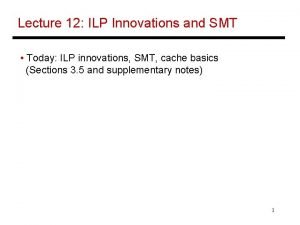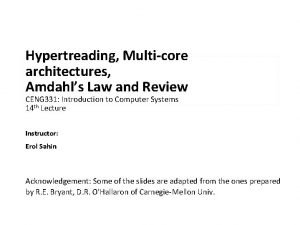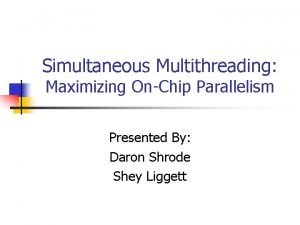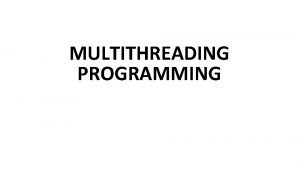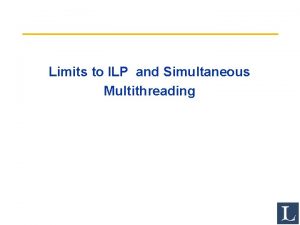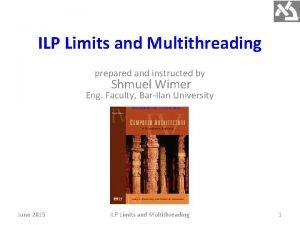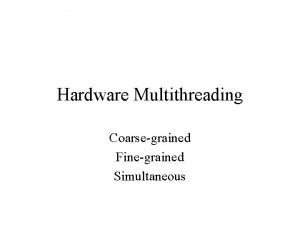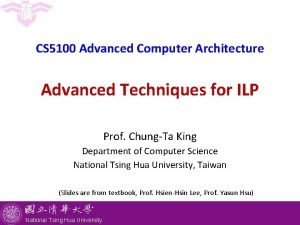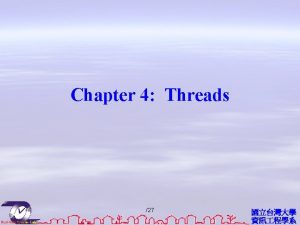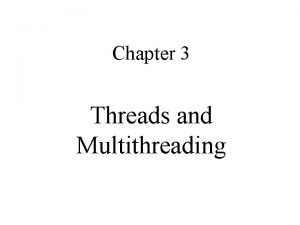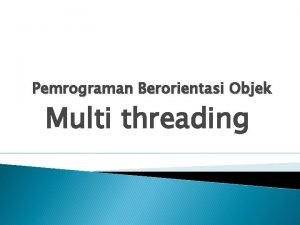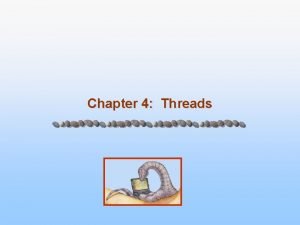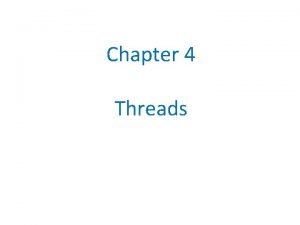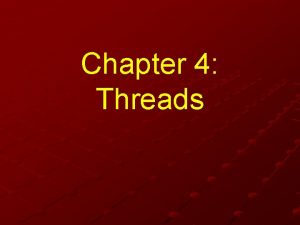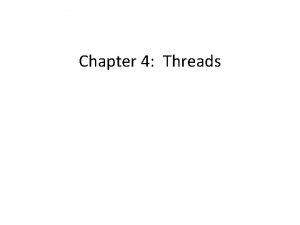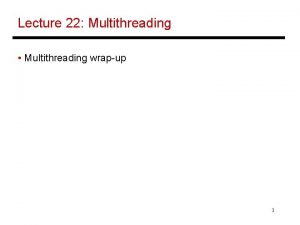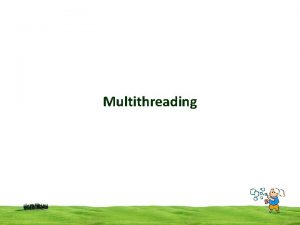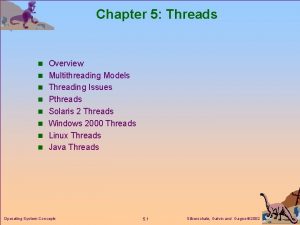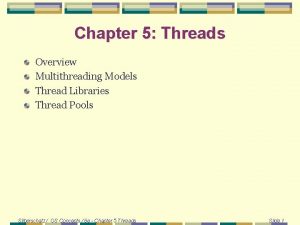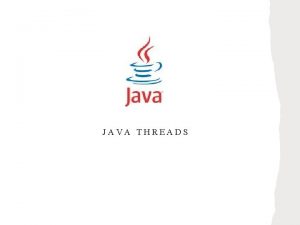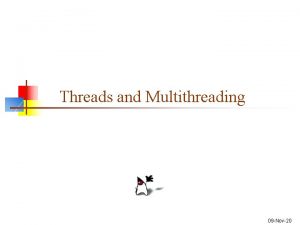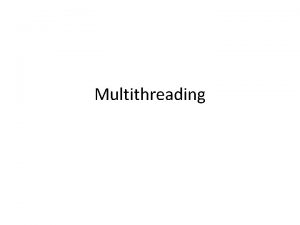Chapter 5 Threads Overview Multithreading Models Threading Issues




















- Slides: 20

Chapter #5: Threads • Overview • Multithreading Models • Threading Issues Operating System Concepts

Threads (Cont. ) q A thread, sometimes called a lightweight process (LWP), is a basic unit of CPU utlization ü It comprises a thread ID, a program counter, a register set, and a stack. ü It shares with other threads belonging to the same process its code section, data section, and other OS resources. , such as open files. q A traditional (or heavyweight) process has a single thread of control. q if the process has multiple threads of control, it can do more than one task at a time, Operating System Concepts

Threads (Cont. ) q Many software packages that run on modern desktop PCs are multithreaded. q. An application typically is implemented as a separate process with several threads of control. q. Examples: Ø A web browser might have one thread display images or text while another thread retrieves data from the network. Ø A word processor may have a thread for displaying graphics, another for reading keystrokes from the user, and a third thread for performing spelling and grammar checking in the background. Operating System Concepts

Multithreaded Process Address space + Threads + Resources • Address space: contains code and data of a process. • Threads: are individual execution contexts. • Resources: are physical support necessary to run the process (memory, disk, …). Operating System Concepts

Single and Multithreaded Processes Operating System Concepts

Benefits • Responsiveness: q Example: a multithreaded web browser could still allow user interaction in one thread while an image is being loaded in another thread. • Resource Sharing: q By default, threads share the memory and the resources of the process to which they belong. q The benefit: it allows an application to have several different threads of activity all within the same address space. Operating System Concepts

Benefits • Economy: q Allocating memory and resources for process creation is costly q It is more economical to create and context switch threads because they share resources. q In general, it is much more time consuming to create and manage processes than threads. • Utilization of multiprocessor Architectures: q Each thread may be running in parallel on a different processor q A single-threaded process can only run on one CPU, no matter how many are available. q Multithreading on a multi-CPU machine increases concurrency Operating System Concepts

Single vs. multiprocessor q. In a single-processor architecture, multithreading generally occurs by time-division multiplexing (as in multitasking): the CPU generally moves between each thread so quickly as to create an illusion of parallelism, but in reality only one thread is running at all time q. On a multiprocessor or multi-core system, the threads or tasks will generally run at the same time, with each processor or core running a particular thread or task. Operating System Concepts

User and Kernel Threads • Support for threads may be provided at either Ø the user level, for user threads, Ø or by the kernel, for kernel threads. Operating System Concepts

User Threads • Thread management done by user-level threads library q Supported and managed above the kernel and are implemented by a thread library at the user level. q The library provides support for thread creation, scheduling, and management with no support from the kernel. q The kernel is unaware of user-level threads, all thread creation and scheduling are done in user space without the need for kernel intervention. q User-level threads are generally fast to create and manage. Operating System Concepts

User Threads (Cont. ) q Drawbacks: if the kernel is single-threaded, then any user-level thread performing a blocking system call will cause the entire process to block, even if other threads are available to run within the application. • Examples: Ø POSIX Pthreads Ø Mach C-threads Ø Solaris 2 UI-threads Operating System Concepts

Kernel Threads • Supported and managed by the Kernel (OS) • The kernel performs thread creation, scheduling, and management in kernel space. • Kernel threads are generally slower to create and manage than are user threads. • If a thread performs a blocking system call, the kernel can schedule another thread in the application for execution. • Also, in a multiprocessor environment, the kernel can schedule threads on different processors. • Examples - Windows 95/98/NT/2000 - Solaris 2 - Tru 64 UNIX - Be. OS Operating System Concepts

Multithreading Models • Many-to-One (User-level threading) • One-to-One (Kernel-level threading) • Many-to-Many (Hybrid threading) Operating System Concepts

Many-to-One • Many user-level threads mapped to single kernel thread • It is efficient because thread management is done in user space • Shortcoming: The entire process will block if a thread makes a blocking system call • Only one thread can access the kernel at a time, therefore multiple threads are unable to run in parallel on multiprocessors • Used on systems that do not support kernel threads. Operating System Concepts

Many-to-One Model Operating System Concepts

One-to-One • Each user-level thread maps to kernel thread. • Allow more concurrency than many-to-one by allowing another thread to run when a thread makes a blocking system call. • It also allows multiple threads to run in parallel on multiprocessors. • Shortcoming: The overhead of creating kernel threads can burden the performance of an application • Examples - Windows 95/98/NT/2000 - OS/2 Operating System Concepts

One-to-one Model Operating System Concepts

Many-to-Many Model (N : M) • Multiplexes many user-level threads to a smaller or equal number of kernel threads • Allows the operating system to create a sufficient number of kernel threads. • Suffers from neither of the shortcomings of the other two approaches (1: 1 and 1: N) q Developers can create as many user threads as necessary q. And the corresponding kernel threads can run in parallel on a multiprocessor. q. The kernel can schedule another thread for execution, when a thread performs a blocking system call. Operating System Concepts

Many-to-Many Model (cont. ) Examples: q Solaris 2 q IRIX q. HP-UX q. Tru 64 UNIX Operating System Concepts

Many-to-Many Model Operating System Concepts
 Multithreading models
Multithreading models Cmpsc 473
Cmpsc 473 Parts of sewing machine under the bed
Parts of sewing machine under the bed Turning tool in workshop
Turning tool in workshop Cnabd
Cnabd Hyper threading
Hyper threading Ue4 taskgraph
Ue4 taskgraph Interlocked pipeline
Interlocked pipeline Com threading model
Com threading model Huber
Huber Hyper threading
Hyper threading Lathe gore
Lathe gore Hyper threading
Hyper threading Hyper threading
Hyper threading Simultaneous multithreading: maximizing on-chip parallelism
Simultaneous multithreading: maximizing on-chip parallelism Real time example of multithreading in java
Real time example of multithreading in java What is thread based preemptive multitasking
What is thread based preemptive multitasking Fine grained multithreading
Fine grained multithreading Fine grained multithreading
Fine grained multithreading Coarse-grained multithreading
Coarse-grained multithreading Fine grained multithreading
Fine grained multithreading
